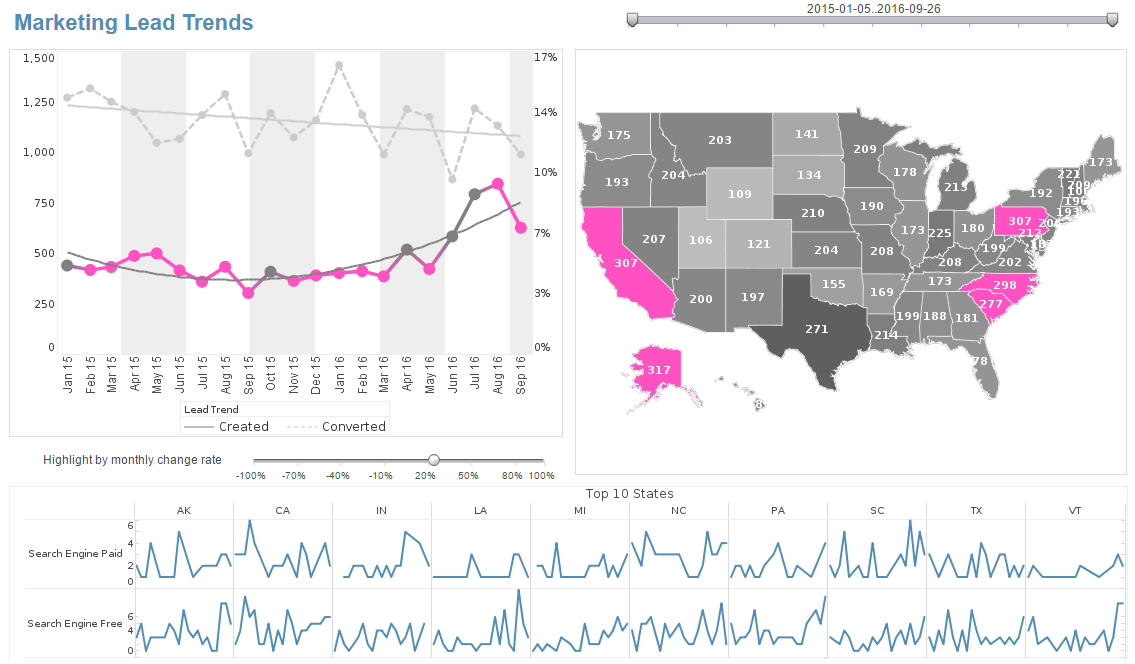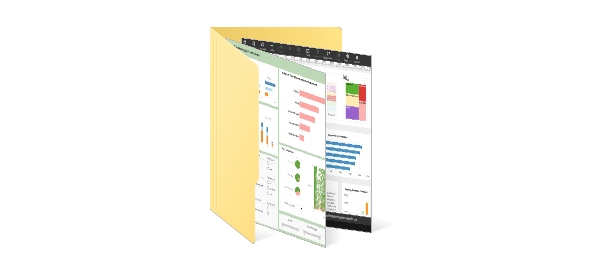Business Analysis Software for Smarter Decisions
StyleBI, InetSoft's flagship business analysis software, will give you the insight into your organization to make better, more informed decisions.
What Making Informed Decisions Can Do for You
The key to running a successful business is making the right decisions. Many managers make their decisions based strictly on their gut, or what "feels right." While this common sense approach may be a terrific motivator for deciding what to wear in the morning, or what to do after work, business decisions require a bit more than just tact to get results.
Good decisions require logic and evidence. These are generated through prior experience and supporting data. Decisions backed by information and proof yield positive results through proven methods.
Make the Right Decision: Choose InetSoft
StyleBI offers your organization many methods for tracking, analyzing, and reporting data, and is a vital tool in the business analysis process.
Data Mining
Data mining is a technology offered though StyleBI that allows you to weed through large caches of data to reveal historical trends, correlations, and/or other data relationships that may influence future decision making.
Data Mashup
Data mashup is a means of combining disparate data sources to produce reports or dashboards that provide new insights and create internal information management efficiencies.
Dashboards and Reporting
Dashboards and reports are the output element produced by StyleBI. They provide an at-a-glance look at the key performance indicators relevant to particular objective or business process.
Recycling the Data Loop: How a Recycling Company Transformed Its Operations with InetSoft’s StyleBI
This article explores how EcoCycle's IT department spearheaded a full-spectrum BI initiative, leveraging the flexibility, scalability, and open-source power of StyleBI to achieve transparency, optimize logistics, and ultimately improve its environmental footprint.
The Need for Data Clarity in Recycling Operations
EcoCycle Solutions operates a network of recycling centers, curbside pickup routes, and sorting facilities across several northeastern states. Their business, while noble in its environmental purpose, was historically plagued by a familiar challenge: disparate data sources with little centralization or harmonization.
Each recycling center used its own system for tracking waste intake, contamination rates, and commodity pricing. Route optimization data was housed in a separate GPS system. Customer feedback and complaints lived in a CRM, while financial reports came from a cloud-based accounting service. As the CIO of EcoCycle, Rachel Menendez, put it: “Our data was as recyclable as our waste: high in volume, low in usability.”
The IT department’s goal was clear—unify the company’s various data silos and create a centralized BI ecosystem that was:
• Scalable and future-proof
• Open source for extensibility
• Lightweight enough to deploy across modest infrastructure
• Capable of handling both structured and semi-structured data
After evaluating proprietary solutions and running up against high licensing fees and rigid architectures, the team discovered InetSoft’s StyleBI—a cloud-native, microservice-ready open source BI tool built for agility.
Deploying StyleBI in a Resource-Conscious Environment
EcoCycle’s IT team had limited resources—both in terms of budget and personnel. The appeal of StyleBI’s small footprint and containerized microservice architecture was immediate. Unlike heavy enterprise BI stacks, StyleBI could be deployed rapidly on existing cloud infrastructure with modest tuning.
The team took a modular approach:
• Data mashup layers were created to integrate multiple sources—CSV files from recycling centers, APIs from logistics vendors, SQL databases from ERP systems, and JSON payloads from IoT sensors on trash bins.
• KPI dashboards were developed for executives, showing real-time performance metrics: collection volumes, cost per ton, contamination rates, and commodity market pricing.
• Role-based access control ensured that each department saw only the data relevant to their function, with row-level security baked in for compliance.
“Within weeks, we had a working dashboard that visualized end-to-end operations across the enterprise,” Menendez shared. “And unlike commercial BI platforms, we didn’t need a team of consultants to build it.”
Real-Time Insight into Waste Streams and Logistics
One of the standout use cases was the monitoring and optimization of waste stream quality. Contamination rates—when non-recyclables are mixed with recyclables—can severely affect resale value and processing costs. Before StyleBI, operators manually sampled truckloads and recorded results on clipboards.
With StyleBI, the process became digital and near real-time:
• IoT sensors at sorting facilities now tag and scan bales of recyclables.
• The data flows into StyleBI where it is mashed up with route data, facility loadouts, and weather conditions (a major contamination factor).
• Supervisors now receive dynamic dashboards that show which routes produce the cleanest recyclables, which drivers need training, and how seasonal changes affect recycling behavior.
Additionally, logistics optimization was overhauled. Using StyleBI’s visual mashup designer, the team created geospatial dashboards that tracked vehicle fuel efficiency, missed pickups, and route overlap. The system integrated with the GIS platform via RESTful APIs, ensuring live map updates and context-rich analysis.
The result? A 17% reduction in fuel costs and a 22% improvement in collection efficiency over six months.
From Reactive to Predictive: The Power of Historical Data
EcoCycle had years of historical data locked in disparate formats. StyleBI's ability to handle both live streams and historical data opened up a new layer of strategic foresight. The IT team set up a big data backend using an open-source columnar store (Apache Parquet), and connected it to StyleBI.
Through machine learning extensions—made possible by StyleBI’s REST integration with Jupyter notebooks and Python scripts—the team began modeling:
• Predictive waste collection volumes based on weather and holidays
• Forecasts of commodity prices for metals and paper
• Predictive maintenance scheduling for vehicle fleets
While StyleBI doesn’t natively perform machine learning, its open architecture allowed seamless connection to external analytics tools. Outputs from predictive models were visualized directly inside dashboards for the operations and finance teams.
Now, instead of reacting to sudden spikes in contamination or missed pickups, EcoCycle can act proactively—with dashboards that show not just what is happening, but what will likely happen next.
Custom Reporting Without Bottlenecks
Prior to StyleBI, every custom report request went through the IT team, resulting in bottlenecks and frustration. With StyleBI’s self-service dashboard design, non-technical users in HR, operations, and sales could create their own visualizations.
This was a game-changer:
• HR managers created workforce dashboards tracking absenteeism and training progress.
• The sales team built dashboards comparing contract profitability by municipality.
• Finance used live dashboards to reconcile supplier payments and recycling credit rebates.
Access controls ensured that while users had design freedom, data governance policies were upheld. StyleBI’s drag-and-drop interface required minimal training—allowing business users to focus on insights, not SQL.
Open Source: Flexibility Without Vendor Lock-In
EcoCycle’s IT leaders are enthusiastic open source advocates. StyleBI’s open core allowed them to customize components, contribute patches, and explore advanced features without needing proprietary plugins or license keys.
They built custom visual widgets using open JavaScript charting libraries, embedded dashboards in their customer-facing portal, and experimented with integrating blockchain for tracking e-waste. None of this would have been possible with a locked-down, commercial BI solution.
More importantly, InetSoft’s open source model gave them full control over their BI destiny. They weren't waiting for quarterly feature releases or constrained by arbitrary data caps. As Menendez remarked, “We wanted to own our data, not lease our insight.”
Impact and Future Roadmap
The introduction of StyleBI has had a profound ripple effect across EcoCycle’s entire organization:
• Executive visibility into key KPIs has improved strategic alignment.
• Operational teams are more efficient and data-literate.
• IT teams are no longer burdened by mundane report generation.
• Environmental impact is now tracked with precision, enabling better sustainability reporting.
Next steps include rolling out mobile dashboards for on-the-ground field workers, integrating StyleBI with drone footage for remote facility monitoring, and expanding to other waste streams like industrial solvents and hazardous waste.
EcoCycle’s journey illustrates that BI isn't just for high-tech firms or financial giants. Even in gritty, logistical industries like recycling, thoughtful deployment of open source tools like StyleBI can radically improve performance, decision-making, and mission delivery.


